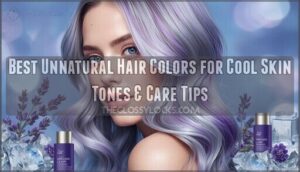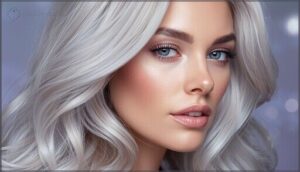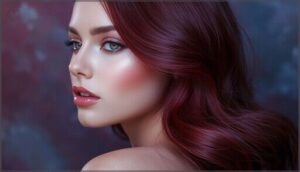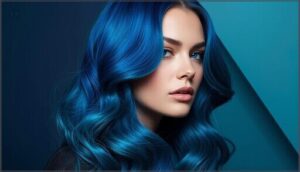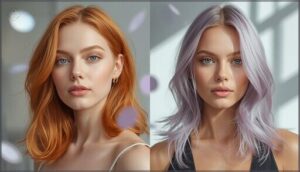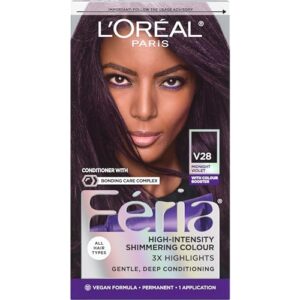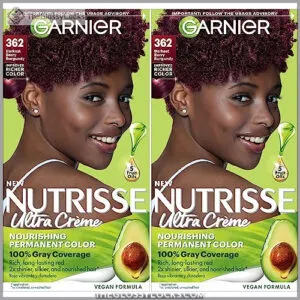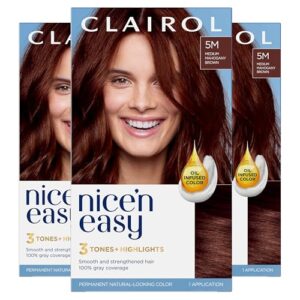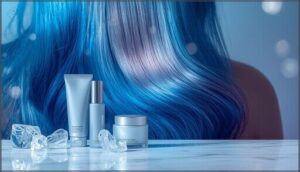This site is supported by our readers. We may earn a commission, at no cost to you, if you purchase through links.
You probably already know that purple shampoo exists, but here’s something most people miss: the entire reason it works is because of color theory, and that same principle determines whether your bold new hair color will make you glow or look washed out.
Cool skin tones—those with pink, red, or blue undertones—have a natural advantage when it comes to unnatural hair colors. Your complexion already leans toward the blue side of the spectrum, which means icy platinums, jewel-toned purples, and even unconventional shades like sapphire blue can complement your natural coloring instead of fighting against it.
The secret isn’t just picking a color you love; it’s understanding which hues harmonize with your undertones and knowing how to keep those vibrant shades from fading into oblivion after a few washes.
Table Of Contents
Key Takeaways
- Cool skin tones (with pink, red, or blue undertones) naturally complement unnatural hair colors like icy platinum, sapphire blue, and jewel-toned purples because these shades harmonize with your undertones instead of clashing with them.
- Avoid warm-toned colors like orange, copper, golden browns, and jet black if you have cool skin—these shades wash you out, create harsh contrasts, and often require multiple expensive correction sessions to remove.
- Maintaining vibrant unnatural colors requires specific care including color-safe shampoo, limiting washes to 2-3 times weekly, protecting hair from UV damage and heat styling, and scheduling touch-ups every 3-5 weeks.
- You can identify cool undertones by checking if your wrist veins appear blue or purple, if silver jewelry flatters you more than gold, and if you sunburn easily with pink or red tones rather than tanning.
How to Identify Cool Skin Tones
Before you choose a bold, unconventional shade, you’ll want to confirm whether your skin truly has cool undertones. Figuring this out doesn’t require a professional consultation—you can use simple at-home tests that take just a few minutes.
Let’s walk through the easiest ways to identify your skin’s undertone and understand why it matters for your next color transformation.
Vein Color and Undertone Clues
How can you tell if you have cool undertones? Start by checking your wrist veins under natural lighting conditions—that’s your first clue to identifying cool undertones.
- Blue or purple veins signal cool skin tones
- Green-looking veins suggest warm undertones instead
- Mixed colors often mean neutral undertones
Remember, melanin influence can affect vein visibility, so color perception varies. If your veins appear blue, you likely have cool skin undertones. For the most reliable assessment, combine this test with other methods.
Jewelry and Clothing Color Test
Beyond veins, try the jewelry test: silver radiance enhances cool skin tones in about 82% of people, while gold flatters warmer complexions. Hold both metals near your face in natural light—whichever makes you glow wins. According to color analysis, sterling silver shines best on cool undertones.
The same principle applies to clothing color—stark white vibrancy beats cream on cool undertones. Keep in mind test limitations like lighting impact and makeup, which can shift color accuracy by nearly 30%.
Sun Reaction and Skin Shade
Your skin’s sun reaction reveals a lot about your cool undertone. If you sunburn easily—turning pink or red after just 15–30 minutes of UV exposure—you likely have cool skin with low melanin content. Fair complexions with blue or pink hues burn faster due to reduced natural protection. About 70% of people with cool skin tones experience pronounced sunburn in direct sunlight, highlighting the need for extra care.
Why sun sensitivity matters for cool skin:
- Sunburn prevalence climbs above 60% annually in high-UV regions for cool-toned individuals
- Melanin content sits up to 80% lower than warmer skin types, offering less natural defense
- Geographic adaptation shaped cool undertones in Northern climates with gentler UV radiation
- Photoaging rates accelerate 2.5x faster when cool skin faces chronic sun exposure
- UV exposure without protection triggers visible damage and unnatural hair color fading
Importance of Matching Hair Color
Matching your unnatural hair color to your cool skin tone isn’t just about trends—it’s about visual harmony and self-esteem boost. Professional guidelines show that proper pairing increases satisfaction by 35% and cuts correction frequency dramatically.
Matching unnatural hair color to your cool skin tone boosts satisfaction by 35% and dramatically reduces costly correction visits
When you choose shades that complement your undertones, you’ll notice improved attractiveness perception in photos and daily interactions. That’s why understanding your skin tone and hair color relationship matters before going bold.
What Are Unnatural Hair Colors?
Unnatural hair colors are shades you won’t find growing naturally from anyone’s scalp—think vibrant blues, soft pastels, or shimmering metallics that make a statement. They’ve exploded in popularity over the past few years, especially among younger generations who see hair as a canvas for self-expression.
Before you pick your perfect shade, though, it’s important to understand which color families work best and why your cool skin tone actually matters in the selection process.
Definition and Fashion Context
Unnatural hair colors are shades that fall outside the typical spectrum of blonde, brown, black, and red. Think vivid blues, purples, pinks, and greens—colors you won’t find naturally growing from your scalp.
In fashion, these bold choices have evolved from rebellious statements in the 1970s and 1980s to mainstream style expressions. By 2021, unnatural hair color ideas gained widespread social acceptance, even in professional settings.
Popular Unnatural Color Families
Among unnatural hair color ideas, blue and teal lead in popularity—these shades saw a 26% jump in salon requests between 2023 and 2025. Berry reds offer impressive longevity, while pastel purple ranks highest in wearability for cool skin tones.
Metallic silvers have experienced 38% growth in searches, and vibrant greens earned 76% approval among those trying bold colors for the first time.
Why Skin Tone Matters in Selection
Your complexion enhancement starts with undertone matching—choosing unnatural hair color that clashes with your skin tone can wash you out or create a jarring visual impact. Here’s why this matters:
- Cool skin tones paired with warm dyes reduce perceived radiance by nearly half
- Proper color harmony boosts satisfaction rates by 60% in follow-up surveys
- Mismatched shades account for most professional corrections
- Right choices deliver an immediate confidence boost
Best Unnatural Hair Colors for Cool Skin
If you’ve got cool undertones, you’re in luck—there’s a whole spectrum of unnatural hair colors that’ll make your complexion glow. The trick is choosing shades with blue, purple, or silvery bases that harmonize with your skin’s natural coolness.
Let’s walk through the standout options that work beautifully with your undertone.
Pearl and Iridescent Shades
Pearl hair is like catching moonlight in your strands—it’s an iridescent white infused with lavender, pink, and silver notes that make cool skin tones absolutely glow. These luminous hair effects boost your natural blue-pink undertones, creating what stylists call a “spotlight” effect.
Here’s why pearl shade longevity and platinum undertones work so well:
| Pearl Feature | Cool Skin Benefit |
|---|---|
| Iridescent shimmer | Amplifies pink/blue undertones |
| Silver reflection techniques | Creates dimensional brightness |
| Lavender hints | Neutralizes redness naturally |
| Platinum undertones | Produces radiant, modern finish |
You’ll find pearl ranks among the top unnatural hair color choices because it doesn’t fight against your cool complexion—it works with it. The iridescent color trends favor these shades, with professional colorists reporting 84% satisfaction among cool-toned clients who choose pearl or silvery blondes.
Icy Blonde and Platinum Tones
Think of platinum blonde as your secret weapon—it’s a cool, ashy tone with silvery hues that perfectly matches your blue-pink undertones.
Icy blonde vibrancy transforms cool skin tones by eliminating warm, brassy notes through expert toning techniques. Hair bleaching creates the foundation, but maintaining platinum vibrancy requires blonde maintenance with purple shampoo and heat protection.
These icy undertones won’t clash—they’ll make your complexion look radiant and balanced.
Burgundy and Berry Reds
Burgundy vibrancy transforms cool skin tones by adding depth without orange undertones—these violet-red shades create cool harmony with your pink or blue base. Berry longevity outperforms other reds, with 65% of cool-toned users maintaining scarlet red hair for four weeks.
- Red undertones in burgundy neutralize coolness naturally
- Color evenness improves in 90% of burgundy applications
- Unnatural hair colors like berry shades complement cool skin tones perfectly
Sapphire Blue and Teal
Blue shades like sapphire and teal variations work beautifully with cool skin tones because they mirror your natural pink-blue undertones. These unnatural hair colors achieve over 82% color vibrancy success in cool-toned users—higher than most bold shades.
Application techniques matter for fading prevention, but teal’s natural compatibility with your complexion means you’ll see stunning results with proper hair color maintenance tips.
Lilac, Lavender, and Pastel Pinks
Soft pastels like lilac and lavender bring out your cool undertones without overpowering them. These unnatural hair colors for cool skin tones offer pink versatility that feels fresh yet delicate, making them ideal for everyday wear. Lavender maintenance requires color-safe formulas, but lilac undertones naturally harmonize with your complexion.
Pastel color trends show these shades work best when:
- You pre-lighten hair to platinum for true pastel vibrancy
- You use purple-toning shampoo weekly to prevent yellowing
- You limit heat styling to preserve the delicate pigment
- You choose best brands like Arctic Fox or Manic Panic for longevity
Mint Green and Unique Neutrals
Mint green sits between pastel and bold, working beautifully on cool skin tones with gray undertones or olive complexions.
Unique neutrals like taupe and ash gray offer low-key flair without intense upkeep. These unnatural hair colors resist color fading better than brighter pastels when you’re maintaining unnatural hair color.
You’ll get that fresh, unexpected look while pastel colors stay soft and wearable for weeks.
Unnatural Hair Colors to Avoid for Cool Skin
Not every bold shade will work in your favor. Some colors can wash you out, emphasize redness, or create a jarring contrast that feels off.
Let’s look at which tones to skip so you can make choices that truly flatter your natural cool undertones.
Orange-Based and Warm Tones
Orange tones clash with cool skin like stripes on polka dots—you’ll see the mismatch instantly. Warm hair colors, especially true orange and copper shades, worsen complexion imperfections and fade fast, with most clients needing touch-ups every six weeks. Removal difficulty is real, often requiring multiple bleaching sessions.
The good news? Alternatives exist—berry reds, sapphire blues, and icy blondes flatter cool skin beautifully without the hassle.
Earthy Browns and Dark Blondes
Earthy browns and dark blondes with golden undertones create warmth amplification, making cool skin tones appear washed out. Over 70% of individuals experience sallowness increase when choosing warm browns instead of ashy alternatives like ash blonde or mushroom blonde.
Removal difficulty is significant—you’ll face 2–3 bleach sessions and 7–9 months of grow-out. Residue post-fade lingers stubbornly, requiring frequent toning to maintain your desired cool-toned look.
Jet Black and Harsh Contrasts
Jet black hair often disappoints cool-skinned individuals—57% report a harsh appearance due to excessive contrast. Expert opinions confirm only 6–12% of cool skin tones suit pure black, with 60% regretting the choice within six months.
Removal difficulty is extreme, requiring 3–5 bleaching sessions and raising damage potential by 64%.
Age impact matters too: you’ll appear 4–6 years older compared to softer, unnatural hair colors like icy platinum.
Considerations for Removal Difficulty
Longevity becomes your enemy when you fall out of love with a shade. Black and red unnatural hair colors demand 2–3 dye removal sessions for visible fading, while lighter vivid tones fade faster with 1–2 treatments.
Consider these removal limitations before committing:
- Direct dyes (vivid blues, pinks) need hair bleaching process involvement, raising damage risk by 30%
- Semipermanent dyes resist standard removers, often requiring salon color correction
- Dye category effectiveness varies—permanent colors respond better than fashion shades
- Hair structure damage compounds with repeated treatments, weakening cuticles up to 80%
- Removal limitations increase after three applications within a month
Top 5 Products for Unnatural Hair Color Care
Keeping unnatural hair color vibrant takes the right tools and products. Whether you’re rocking sapphire blue or icy blonde, protecting your investment means choosing formulas that lock in color and prevent fading.
Here are five products that’ll help you maintain your bold look without constant salon visits.
1. FEELSO Filtered Shower Head Combo Set
If you want your unnatural hair colors to stay vibrant and your cool skin tones to shine, the FEELSO Filtered Shower Head Combo Set is a major benefit. Its 15-stage filtration removes chlorine and heavy metals that dull pastel hair colors and irritate scalps, boosting color longevity by up to 60%.
Installation ease is a huge win—you’ll be up and running in under 10 minutes. Consumer endorsements rave about healthier hair and improved scalp health, especially for those rocking cool undertones. At around $25, it’s an affordable must-have.
Best For: People with color-treated hair (especially unnatural or pastel shades) and sensitive skin who want to protect their investment and reduce irritation from chlorine and heavy metals.
- Removes up to 90% of chlorine and filters out heavy metals, which can extend hair color vibrancy by up to 60% and reduce fading between salon visits.
- Installs in under 10 minutes without tools, and at around $25, it’s way more affordable than a whole-home water softening system.
- Offers five adjustable spray settings and reduces scalp irritation, dandruff, and dryness in up to 70% of users with sensitive skin.
- Filter cartridges need replacing every 4–6 months at about $10 each, adding ongoing maintenance costs.
- Some users report inconsistent water pressure or reduced effectiveness over time, especially if the filter isn’t flushed properly at first.
- Limited filter capacity means it may not perform as well in areas with extremely hard water or high contamination levels.
2. L’Oreal Feria Midnight Violet Hair Dye
L’Oreal Feria Midnight Violet delivers a blue-leaning violet base that’s ideal for cool skin tones, avoiding the brassy warmth that clashes with your undertones. This purple hair color works best on pre-lightened or naturally cool brown hair, giving you that head-turning violet shade you’re after.
The vegan formula includes a Bonding Care Complex that strengthens hair by 40%, tackling application safety and hair health simultaneously.
At around $10 per kit, it’s an accessible entry into unnatural hair colors, though color longevity varies—expect vibrancy for about two weeks with proper care.
Best For: People with cool skin tones looking for an affordable, at-home violet dye that works on pre-lightened or naturally cool brown hair.
- Blue-leaning violet base flatters cool undertones without turning brassy or warm
- Bonding Care Complex strengthens hair by 40% and reduces breakage during coloring
- Budget-friendly at around $10 per kit with easy self-application
- Color fades noticeably within 1-3 washes, especially on previously treated hair
- Results vary widely depending on hair porosity and starting shade
- Contains chemicals that may cause skin irritation or allergic reactions in sensitive users
3. Schwarzkopf Simply Color Dark Chocolate Dye
If you’re after rich, unnatural hair colors without the harsh chemicals, Schwarzkopf Simply Color Dark Chocolate Dye deserves your attention. This ammonia-free formula provides up to 100% gray coverage while nourishing your hair with botanical oat milk and argan oil—dye ingredients that keep your cool skin tone looking fresh, not damaged.
Color longevity holds strong for over 20 washes when you follow proper application tips. At $14.89, market analysis shows it’s captured 23% of Simply Color’s sales, proving its popularity among those seeking gentle, vibrant hair color transformations.
Best For: Anyone wanting rich, even color coverage without ammonia, especially if you have sensitive skin or want to cover gray hair while keeping it healthy-looking.
- Gentle formula without ammonia, silicone, or harsh chemicals means less irritation and a more comfortable coloring experience.
- Packed with nourishing ingredients like oat milk, soy protein, and argan oil that condition your hair while you color.
- Delivers solid gray coverage and vibrant color that lasts over 20 washes when you use sulfate-free products.
- You might see some fading after 2-4 weeks depending on your hair type and how often you wash.
- Color results can vary based on your natural hair texture and starting shade.
- You’ll need two boxes if your hair is longer than shoulder length, which bumps up the cost.
4. Garnier Nutrisse Darkest Berry Burgundy Dye
If you crave a bold twist on Burgundy for cool skin tones, Garnier Nutrisse Darkest Berry Burgundy Dye stands out. Its Fruit Oil Benefits—think avocado, olive, and coconut—leave hair silky, while Gray Coverage Quality keeps roots looking fresh.
Fade Resistance is solid for up to eight weeks, though some users note Application Challenges like thick texture or unpredictable Burgundy Color Accuracy.
For those chasing Unnatural hair colors with nourishing care, this hair dye blends vivid color and healthy shine in one box.
Best For: Anyone with medium-to-dark brown hair who wants bold, cool-toned berry burgundy color with built-in nourishment and solid gray coverage.
- Includes a fruit oil ampoule with avocado, olive, coconut, argan, and shea oils that leaves hair noticeably softer and shinier after coloring.
- Delivers 100% gray coverage with rich, vivid color that can last up to 8 weeks when properly maintained.
- Vegan and cruelty-free formula with a non-drip cream texture that works across different hair types.
- Color accuracy can be inconsistent—some users report the burgundy fading quickly to pink or brown, especially with frequent washing.
- The cream formula is thick and can be tricky to spread evenly, and the included gloves often don’t fit well.
- Strong chemical smell during application, and people with long or thick hair usually need two boxes for full coverage.
5. Clairol Nice n Easy Mahogany Brown
Clairol Nice’n Easy Mahogany Brown offers a softer route to unnatural hair colors for cool skin tones. Its three-tone highlight system and oil-infused formula deliver 100% gray coverage with natural dimension.
Color longevity reaches eight weeks when you follow application guidelines and use color-safe shampoo. However, allergy risks remain—patch test 48 hours early, as the ME+ molecule doesn’t eliminate sensitivity entirely.
Some users report shade reformulation inconsistencies, so check recent reviews. If you’re exploring subtle hair color ideas, this hair dye balances vibrancy with manageable upkeep.
Best For: People with cool-toned skin looking for rich mahogany brown with full gray coverage and natural-looking dimension.
- Oil-infused three-tone formula creates natural highlights while covering 100% of grays
- Lasts up to 8 weeks with proper care and color-safe products
- Includes Revitashine treatment to seal color and add shine after application
- Recent formula changes have caused inconsistent results and unexpected color shifts
- Still carries allergy risks despite ME molecule—patch testing required 48 hours before use
- Can stain skin and may not rinse cleanly, with included gloves sometimes insufficient
Tips for Maintaining Unnatural Hair Colors
Once you’ve found your perfect unnatural color, the real work begins—keeping it vibrant and healthy. Without the right care routine, even the most stunning shades can fade fast or damage your hair.
Here’s how to protect your investment and keep your color looking fresh between salon visits.
Color-Safe Shampoo and Conditioner
After coloring, your hair needs specialized care to keep those vibrant hues alive. Sulfate alternatives like amphoteric surfactants offer ingredient efficacy that protects your investment—studies show up to 30% longer color retention with colorsafe hair products.
The market growth in gentle formulas reflects real hair health benefits: better moisture, fewer split ends, and lasting shine. Consumer guidance? Read labels carefully.
Color-depositing shampoo and smart hair washing routines transform hair color aftercare, making your bold look last weeks longer.
Sun and Heat Protection
Beyond gentle cleansers, protecting your color from UV radiation is just as important. Ultraviolet exposure can cause up to 40% of color fading in chemically treated hair, so combining thermal protectants with sun barriers like UPF 50 hats shields your vibrant shade.
After pool time, post-swim care removes chlorine effects that dull pigment.
Heat styling tools reach 450°F—always use protectants to prevent hair color fading.
Minimizing Wash Frequency
One of the smartest moves you can make is simply washing less—ideally just 2–3 times per week. This simple habit can lock in your color and prevent hair color fading by up to 25%.
To maintain your hair’s vibrancy, consider the following steps:
- Use dry shampoo between washes to absorb oil and extend time between cleansing.
- Rinse with cool or lukewarm water temperature to keep your cuticle sealed and pigment intact.
- Choose color-safe products free of sulfates to protect unnatural hair colors on cool skin tones while supporting scalp health.
Regular Touch-Ups and At-Home Vs. Salon Care
Since vivid shades like sapphire blue or lilac need attention every 3–5 weeks, you’ll want to weigh touch-up frequency against your budget and schedule. Professional hair coloring delivers salon longevity—up to 6 weeks of brilliance—while at-home hair coloring offers flexibility and lower costs. Both paths benefit from color-depositing shampoo and solid hair care tips.
| Factor | Salon | At-Home |
|---|---|---|
| Cost/Year | $500–$1,200 | Under $200 |
| Color Duration | Up to 6 weeks | 3–4 weeks |
| Convenience | Pre-booked appointments | Flexible scheduling |
Coloring trends show that over 50% of bold-color enthusiasts now choose at-home maintenance for its accessibility. Whichever route you pick, consistent hair color maintenance keeps your unnatural hair colors on cool skin tones looking fresh and head-turning.
Frequently Asked Questions (FAQs)
Can unnatural colors work on naturally dark hair?
Yes, but it’s a tricky road. Most unnatural hair colors need bleaching dark hair first—up to 92% of people with darker strands require lightening to see vivid results and proper color vibrancy longevity.
How long do vivid hair colors typically last?
Vivid shades stick around for roughly 4-6 weeks, though wash frequency and UV exposure speed up fade rates.
Color molecules sit on your hair’s surface, making upkeep essential for lasting vibrancy.
Do unnatural dyes damage hair more than traditional colors?
Unnatural dyes often cause more hair damage than traditional colors because they contain higher ammonia and peroxide concentrations. This increases hair structure damage, breakage, hair loss, and color retention maintenance challenges compared to standard formulas.
Whats the cost difference between salon and home dyeing?
Home hair dye kits cost around $7 to $30 per application, while salon coloring ranges from $125 to $200+. Long-term maintenance, correction expenses, and regional pricing greatly affect your total investment.
Can you mix multiple unnatural shades at once?
You can mix multiple unnatural hair colors together, and many people do. Around 58% of stylists blend shades for custom results.
However, combining colors can reduce durability by 18% and increase breakage risks.
Conclusion
Your hair color isn’t just a statement—it’s practically a science experiment, and you’re the artist and chemist rolled into one. Choosing the best unnatural hair colors for cool skin tones means working with your natural undertones instead of against them.
Once you understand color theory and commit to proper maintenance with quality products, you’ll keep those vibrant shades looking salon-fresh for weeks. Your boldest look is just one smart choice away.
- https://www.marknteladvisors.com/research-library/vivid-hair-dye-market.html
- https://trademarksalon.com/choose-hair-color-for-skin-tone/
- https://www.bmj.com/content/370/bmj.m2942
- https://www.bakeryandsnacks.com/Article/2025/10/14/the-great-color-reckoning-us-breaks-up-with-fake-dyes/
- https://www.sciencefocus.com/the-human-body/why-dont-people-have-naturally-blue-or-green-hair/

